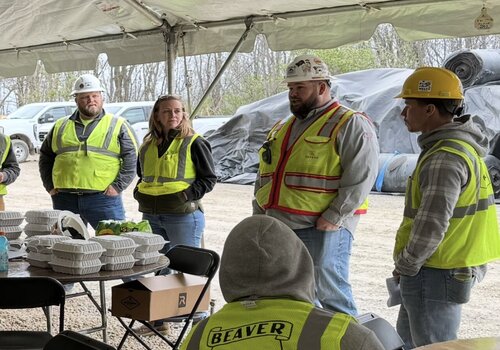Every August, National Traffic Awareness Month offers a crucial reminder: the roads we work near can be as dangerous as the jobsite itself. For contractors operating on highways or urban roads, observing Traffic Awareness Month isn’t just symbolic—it’s a vital opportunity to reinforce worker safety and save lives.
WHAT IS TRAFFIC AWARENESS MONTH—AND WHY IT MATTERS
Observed annually in August, National Traffic Awareness Month focuses on reducing traffic related incidents and raising road safety awareness among drivers and workers. For contractors, the significance is clear.
Contractors are responsible for workers who are exposed daily to fast-moving traffic, shifting site conditions and visibility challenges. By strengthening traffic awareness, teams can proactively reduce risks and demonstrate leadership in workplace safety.
Traffic Awareness Month is a meaningful checkpoint—an opportunity to re-engage staff on traffic protocols, assess site practices and renew leadership’s visible commitment to safety.
CONSTRUCTION WORKERS KILLED IN TRAFFIC RELATED INCIDENTS ON JOBSITES
The Bureau of Labor Statistics’ most recent Census of Fatal Occupational Injuries (CFOI) reports that in 2023, the construction industry suffered 1,075 total fatalities, the highest since 2011.
-
Transportation incidents are the second-leading cause of construction fatalities accounting for 22.3 percent of construction related deaths.
-
Longterm CFOI tracking shows that road construction site fatalities have fluctuated between 82 and 143 annually from 2014–2022—but trending downward recently—while struck by incidents remain a consistent and urgent hazard.
-
While 2024-specific data from CFOI is not yet finalized, these numbers provide the most recent benchmarks available. Given the ongoing trends in highway work-zone incidents and struck-by accidents, transportation risks remain a leading cause of fatality in construction.
4 SIMPLE WAYS TO PARTICIPATE IN TRAFFIC AWARENESS MONTH
By proactively addressing transportation-related hazards—through planning, training, and communication—contractors can protect more workers from preventable tragedy. Here are practical actions contractors can take today to honor Traffic Awareness Month and raise traffic safety awareness:
1. Conduct Toolbox Talks or Safety Meetings
Launch August with a focused safety talk on traffic awareness. Discuss real accident scenarios, proper signage and strategies for safe navigation around moving vehicles. Prioritize safe driving among subcontractors and fleet operators, especially where narrow or shifting lanes are present.
2. Review Internal Traffic Control Plans (ITCPs)
Update or implement Internal Traffic Control Plans (ITCP) to manage the movement of vehicles and heavy equipment within the work zone. An effective ITCP separates pedestrian zones from machinery and reduces struck-by risks—a major cause of construction fatalities. OSHA’s Roadway Work Zone Alliance provides free guides.
3. Reinforce Personal Protective Equipment (PPE)
Ensure all crew members wear high-visibility apparel that meet safety standards, including reflective vests, shirts and outerwear appropriate for day and night conditions. In addition, provide comprehensive training focused on struck-by hazards, including equipment blind spots, work zone awareness, and safe practices for operating near live traffic and moving machinery.
4. Embrace Technology
Technology enhances traffic safety for construction workers by enabling real-time alerts, geofencing and equipment proximity warnings. Wearables and sensors notify crews of nearby moving vehicles, while smart work zone systems manage traffic flow. These tools help prevent struck-by incidents and improve awareness in high-risk roadside environments.
HOW TO KEEP TRAFFIC SAFETY FRONT OF MIND ALL YEAR
Traffic Awareness Month is just the starting point. Here’s how contractors can keep traffic safety as an ongoing topic all year long.
Ongoing Training and Refreshers: Schedule regular refresher training—especially before major projects or when summer weather increases traffic density. Use interactive modules from organizations such as AGC’s Highway Worker Safety Training Program.
Data-Driven Audits and Incident Tracking: Analyze near miss reports, traffic incidents and speeding events around jobsites. Use this data to identify patterns and adjust traffic control strategies or signage accordingly.
Promote a Safety-First Culture: Leadership should regularly reinforce safe driving behavior in company communications. Recognize crews who properly implement ITCPs or maintain low incident counts. Consider incentives or small awards for safety excellence.
Leverage Technology: Use telematics or vehicle-mounted cameras to detect distracted driving or unsafe maneuvers. In-vehicle alerts or fleet management tools help monitor behavior and reinforce expectations over time.
Make sure all your workers go home to their loved ones this summer. Learn about nighttime paving tips and build a culture of road safety all year with these three road safety tips.
Photo credit: SHUTTERSTOCK/F ARMSTRONG PHOTOGRAPHY












